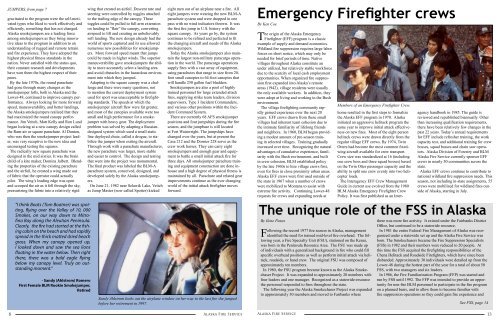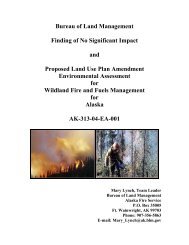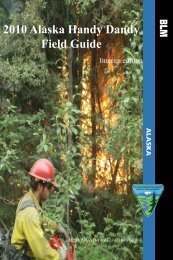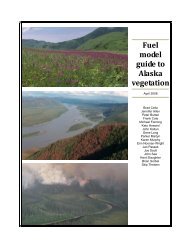Celebrating 25 Years - Alaska Interagency Coordination Center ...
Celebrating 25 Years - Alaska Interagency Coordination Center ...
Celebrating 25 Years - Alaska Interagency Coordination Center ...
You also want an ePaper? Increase the reach of your titles
YUMPU automatically turns print PDFs into web optimized ePapers that Google loves.
JUMPERS, from page 7<br />
gravitated to the program were the self-motivated<br />
types who liked to work effectively and<br />
efficiently, something that has not changed.<br />
<strong>Alaska</strong> smokejumpers are a leading force<br />
among smokejumpers as they bring innovative<br />
ideas to the program in addition to an<br />
understanding of rugged and remote terrain<br />
and fire experience. They have adopted the<br />
highest physical fitness standards in the<br />
nation. Never satisfied with the status quo,<br />
their constant research and developments<br />
have won them the highest respect of their<br />
peers.<br />
By the late 1970s, the round parachute<br />
had gone through many changes as the<br />
smokejumper lofts, both in <strong>Alaska</strong> and the<br />
Lower-48, continued to improve canopy performance.<br />
Always looking for more forward<br />
speed, maneuverability, and better landings,<br />
the <strong>Alaska</strong> smokejumpers realized that they<br />
had maximized the round canopy performance.<br />
Jim Veitch, Matt Kelly and Ron Lund<br />
began looking at a new canopy design called<br />
the Ram-air or square parachute. Al Dunton,<br />
who was then the smokejumper project leader,<br />
was very receptive to the new idea and<br />
encouraged testing the squares.<br />
The radically new square parachute was<br />
designed in the mid sixties. It was the brain<br />
child of a kite maker, Domina Jalbert. Blending<br />
the properties of the existing parachute<br />
and the airfoil, he created a wing made out<br />
of fabric that the operator could actually<br />
pilot. The wing’s leading edge was open<br />
and scooped the air as it fell through the sky,<br />
pressurizing the fabric into a relatively rigid<br />
8<br />
“I think Boats (Tom Boatner) was spotting,<br />
flying over the Valley of 10, 000<br />
Smokes, on our way down to Mitrofina<br />
Bay along the Aleutian Peninsula.<br />
Clearly, the fire had started at the fishing<br />
cabin on the beach and had rapidly<br />
spread in the thick matted dried beach<br />
grass. When my canopy opened up,<br />
I looked down and saw the sea lions<br />
floating in the water below. Then right<br />
there, there was a bald eagle flying<br />
below my canopy level. Truly an outstanding<br />
moment.”<br />
- Sandy (Ahlstrom) Romero<br />
First Female BLM Rookie Smokejumper,<br />
Retired<br />
wing that created an airfoil. Descent rate and<br />
steering were controlled by toggles attached<br />
to the trailing edge of the canopy. These<br />
toggles could be pulled to full arm extension<br />
on landing to “flair” the canopy, converting<br />
airspeed to lift and creating an unbelievably<br />
soft landing. The new design already had the<br />
world of sports captured and its use allowed<br />
numerous new possibilities for smokejumpers.<br />
More forward speed meant that jumps<br />
could be made in higher winds. The superior<br />
maneuverability gave smokejumpers the ability<br />
to more accurately select a landing area<br />
and avoid obstacles in the hazardous environment<br />
into which they jumped.<br />
Adapting to the square canopy was a challenge<br />
and there were many questions, not<br />
to mention the current deployment system<br />
used for sport was unacceptable to firefighting<br />
standards. The speeds at which the<br />
smokejumper aircraft flew were far greater,<br />
and most of the canopies available were too<br />
small and high performance for a smokejumper<br />
with heavy gear. The deployment<br />
problem was solved by adapting a Russiandesigned<br />
system which used a small static<br />
line deployed chute, called a drogue, to stabilize<br />
the jumper when exiting the aircraft.<br />
Through work with a parachute manufacturer,<br />
the new parachute was larger, more stable<br />
and easier to control. The design and testing<br />
that went into the project was monumental.<br />
The final product was labeled the BLM-A<br />
parachute system, conceived, designed, and<br />
developed solely by the <strong>Alaska</strong> smokejumpers.<br />
On June 21, 1982 near Selawik Lake, Veitch<br />
as Jump Master (now called Spotter) kicked<br />
eight men out of an airplane near a fire. All<br />
eight jumpers were wearing the new BLM-A<br />
parachute system and were dropped in one<br />
pass with no wind indicators thrown. It was<br />
the first fire jump in U.S. history with the<br />
square canopy. As years go by, the system<br />
continues to be refined and perfected to fit<br />
the changing aircraft and needs of the <strong>Alaska</strong><br />
smokejumpers.<br />
Today the <strong>Alaska</strong> smokejumpers also maintain<br />
the largest non-military paracargo operation<br />
in the world. The paracargo operations<br />
supply fires with a vast array of equipment,<br />
using parachutes that range in size from 20foot<br />
small canopies to 64-foot canopies that<br />
will handle <strong>25</strong>0 gallon fuel bladders.<br />
Smokejumpers are also a pool of highly<br />
trained personnel for large extended attack<br />
fires, supplying strike team leaders, division<br />
supervisors, Type 3 Incident Commanders,<br />
and various other positions within the Incident<br />
Command System.<br />
There are currently 68 AFS smokejumper<br />
positions and four jumpships during the fire<br />
season, and the jumpbase is still located<br />
at Fort Wainwright. The jumpships have<br />
changed over the years, but at present the<br />
Casa 212 and the Dornier 228 serve as the<br />
crew work horses. They can carry eight<br />
smokejumpers and enough gear and equipment<br />
to battle a small initial attack fire for<br />
three days. All smokejumper parachute training<br />
and equipment construction are done inhouse<br />
and a high degree of physical fitness is<br />
maintained by all. Parachute and related gear<br />
improvements continue as the ever changing<br />
world of the initial attack firefighter moves<br />
forward.<br />
Sandy Ahlstrom looks out the airplane window on her way to the last fire she jumped<br />
before her retirement in 1997.<br />
<strong>Alaska</strong> Fire Service<br />
Emergency Firefighter crews<br />
By Ken Coe<br />
The origin of the <strong>Alaska</strong> Emergency<br />
Firefighter (EFF) program is a classic<br />
example of supply and demand economics.<br />
Wildland fire suppression requires large labor<br />
forces on short notice, which may only be<br />
needed for brief periods of time. Native<br />
villages throughout <strong>Alaska</strong> constitute an<br />
under utilized, but relatively stable workforce<br />
due to the scarcity of local cash employment<br />
opportunities. When organized fire suppression<br />
first expanded into <strong>Alaska</strong>’s remote<br />
areas (1942), village residents were usually<br />
the only available workers. In addition, they<br />
were adept at living and working in the Bush<br />
environment.<br />
The village firefighting community rapidly<br />
gained experience over the next 20<br />
years. EFF crews drawn from these small<br />
villages had inherent team cohesion due to<br />
the intimate familiarity of lifelong friends<br />
and neighbors. In 1960, BLM began providing<br />
a modest amount of pre-season training<br />
in selected villages. Training gradually<br />
increased over time. Recognizing the natural<br />
advantages of cumulative experience, familiarity<br />
with the Bush environment, and built<br />
in crew cohesion, BLM established policy<br />
by the late 1960s to hire village crews first,<br />
even for fires in close proximity urban areas.<br />
<strong>Alaska</strong> EFF crews were first used outside of<br />
the state in 1967 when a number of crews<br />
were mobilized to Montana to assist with<br />
extreme fire activity. Continuing Lower-48<br />
requests for crews and expanding needs at<br />
home resulted in the first steps to formalize<br />
the <strong>Alaska</strong> EFF program in 1970. <strong>Alaska</strong><br />
initiated an aggressive helitack program the<br />
same year to improve initial attack effectiveness<br />
on new fires. Most of the eight person<br />
helitack crews were drawn directly from the<br />
regular village EFF crews. By 1974, Twin<br />
Otters had become the most common fixedwing<br />
aircraft available for crew transport.<br />
Crew size was standardized at 16 (including<br />
one crew boss and three squad bosses) based<br />
on the Twin Otter passenger capacity and the<br />
ability to split one crew evenly into two helicopter<br />
loads.<br />
The <strong>Interagency</strong> EFF Crew Management<br />
Guide in current use evolved from the 1980<br />
BLM <strong>Alaska</strong> Emergency Firefighter Crew<br />
Policy. It was first published as an Inter-<br />
agency handbook in 1985. The guide is<br />
reviewed and republished biannually. Other<br />
than increasing qualification requirements,<br />
there have been relatively few changes in the<br />
past 22 years. Today’s annual requirements<br />
for EFF include refresher training, the work<br />
capacity test, and additional training for crew<br />
bosses, squad bosses and chain saw operators.<br />
<strong>Alaska</strong> Division of Forestry and BLM<br />
<strong>Alaska</strong> Fire Service currently sponsor EFF<br />
crews in nearly 50 communities across the<br />
state.<br />
<strong>Alaska</strong> EFF crews continue to contribute to<br />
national wildland fire suppression needs. This<br />
season, not including in-state assignments, 55<br />
crews were mobilized for wildland fires outside<br />
of <strong>Alaska</strong>, starting in July.<br />
The unique role of the FSS in <strong>Alaska</strong><br />
By Ilene Penas<br />
Following the record 1977 fire season in <strong>Alaska</strong>, management<br />
identified the need for trained mid-level fire overhead. The following<br />
year, a Fire Specialty Unit (FSU), stationed on the Kenai,<br />
was born in the Peninsula Resource Area. The FSU was made up<br />
of individuals with a generalized background in fire who could fill<br />
specific overhead positions as well as perform initial attack via helitack,<br />
roadside, or hand crew. The original FSU was composed of<br />
approximately ten members.<br />
In 1980, the FSU program became known as the <strong>Alaska</strong> Smokechaser<br />
Project. It was expanded to approximately 20 members with<br />
four leaders and one manager. Recognized as a statewide-resource<br />
the personnel responded to fires throughout the state.<br />
The following year the <strong>Alaska</strong> Smokechaser Project was expanded<br />
to approximately 30 members and moved to Fairbanks where<br />
Members of an Emergency Firefighter Crew.<br />
there was more fire activity. It existed under the Fairbanks District<br />
Office, but continued to be a statewide resource.<br />
In 1981 the entire Federal Fire Management of <strong>Alaska</strong> was reorganized<br />
under a statewide set up and the <strong>Alaska</strong> Fire Service was<br />
born. The Smokechasers became the Fire Suppression Specialists<br />
(FSS) in 1982 and their numbers were reduced to 20 people. At<br />
this time the FSS acquired the firefighting responsibilities of the<br />
Chena Helitack and Roadside Firefighters, which have since been<br />
disbanded. Approximately 30 individuals were detailed up from the<br />
Lower-48 during the hottest part of the year for a total of about 50<br />
FSS, with two managers and six leaders.<br />
In 1986, the Fire Familiarization Program (FFP) was started and<br />
run by FSS until 1992. The FFP was intended to provide an opportunity<br />
for non-fire BLM personnel to participate in the fire program<br />
on a planned basis, and to allow them to become familiar with<br />
fire suppression operations so they could gain fire experience and<br />
See FSS, page 14<br />
<strong>Alaska</strong> Fire Service 13

















